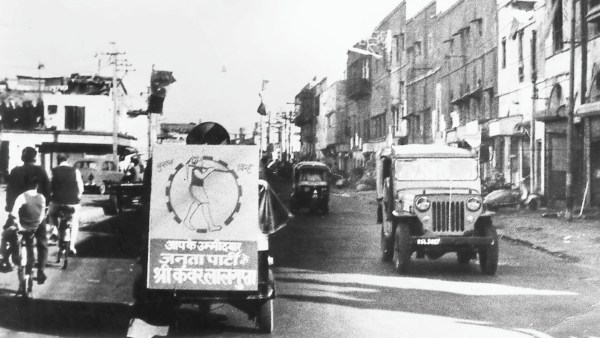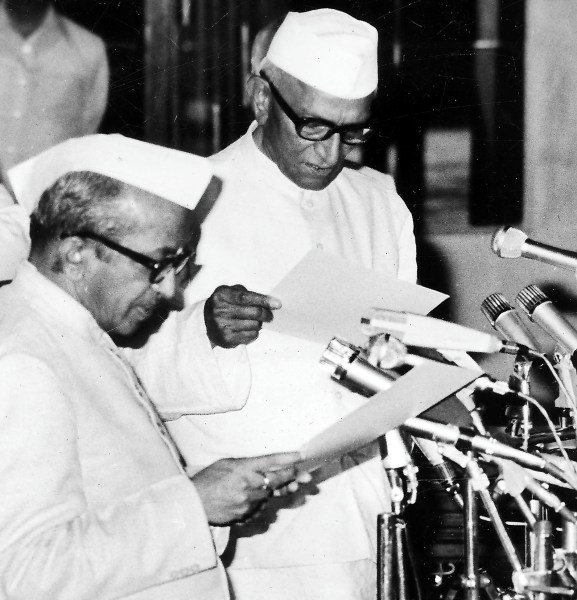The Lok Sabha election of 1977 brought the country’s first non-Congress government to power. Indira Gandhi’s popularity after the 1971 war was dealt big blows by the students’ movement in Gujarat and Jayaprakash Narayan’s call for Total Revolution. When in 1975, Allahabad High Court set aside her election in 1971 on grounds of electoral malpractice, Indira responded by imposing the Emergency. In the election held after the Emergency was lifted, the people handed her a crushing defeat, and Morarji Desai became Prime Minister.
In December 1973, students in an engineering college in Ahmedabad began a protest against a hike in hostel mess charges, which rapidly spread to other campuses in Gujarat and elsewhere, and attracted the support of workers, teachers, and other groups in a broad ‘Navnirman Andolan’ against economic hardships and corruption.
In March 1974, student protesters in Bihar approached the socialist leader Jayaprakash Narayan, who was then 72, to provide leadership to their movement. JP, who had entered self-imposed political exile after the first Lok Sabha election, had seen the youth in Gujarat force Chief Minister Chimanbhai Patel from power in February 1974, and recognised the ability of students to bring about change that would help realise his idea of a new politics distinct from the one he had wearied of.
At a rally in Patna on June 5, 1974, JP gave his famous call for “Sampoorna Kranti” or Total Revolution, implying all-round political, economic, social, cultural, intellectual, educational, and spiritual change.
Indira’s disqualification
In the 1971 election, Indira defeated her socialist rival Raj Narain at the Rae Bareli seat by a margin of more than 1 lakh 11 thousand votes. Raj Narain filed an election petition in Allahabad High Court, challenging the result. On June 12, 1975, Justice Jagmohan Lal Sinha of the High Court struck down the result, declared Raj Narain the winner, and unseated Indira from Lok Sabha.
Indira challenged the HC decision in the Supreme Court. On June 24, 1975, Justice V R Krishna Iyer upheld her disqualification, but allowed her to remain in office until the resolution of her appeal.
The Emergency months
Late in the evening of June 25, 1975, President Fakhruddin Ali Ahmed, acting on the advice of the Prime Minister, issued a proclamation of Emergency under Article 352(1) of the Constitution, which at that time empowered him to do so on grounds of threat to the security of the nation from “war or external aggression” or “internal disturbance”.
The Constitution (Forty-fourth Amendment) Act, 1978 subsequently replaced the words “internal disturbance” with “armed rebellion”.
Following the declaration of the Emergency, more than 1 lakh protesters and critics of the government, including almost all Opposition leaders, were arrested under the Maintenance of Internal Security Act (MISA) and Defence of India Rules. The press was muzzled and censored, and journalists across the country were arrested.
Indira’s younger son Sanjay Gandhi played the key role in the government during the 21 months when the Emergency was in force. A “20-point” programme was implemented with great discipline; Sanjay had his own “five-point” programme that included a sweeping campaign of forced sterilisation that led to massive unrest countrywide.

Birth of the Janata Party
The Lok Sabha election that was due in early 1976 was delayed, and the term of the existing House was extended by enacting a law and amending the Constitution. On January 18, 1977, Indira unexpectedly advised the President to dissolve Lok Sabha with immediate effect. The sixth Lok Sabha election was called in March.
There were seven national parties and 18 state parties in India at the time. Days after the election was announced, however, four national parties — Morarji Desai’s Congress (O), Chaudhary Charan Singh’s Bharatiya Lok Dal (BLD), Atal Bihari Vajpayee and L K Advani’s Bharatiya Jana Sangh (BJS, precursor of the BJP) and Socialist Party — merged to form a new party called Janata Party.
When the Election Commission of India (ECI) declined to recognise the new party, the component parties of Janata decided to contest under the BLD’s symbol of ‘Haldhar within Wheel’. In Tamil Nadu and Pondicherry, Janata contested on the Congress (O)’s ‘Charkha being plied by a Woman’.
The CPI, which supported the Emergency, did not join the Janata Party. However, the CPI(M) made seat adjustments with Janata.
Historic election and result
Following a fresh delimitation of constituencies based on the Census of 1971, the new Lok Sabha was to have 543 members. Votes were cast between March 16 and 20, 1977, and counting was taken up immediately. 60.53% of the 32.11-crore electorate voted; the highest turnout (79.21%) was in Kerala and lowest (44.32%) in Orissa. There were some cases of booth-capturing, illegal removal of ballot boxes and ballot papers from polling stations, and destruction of ballot papers and ballot boxes.
The Janata Party (officially still BLD) emerged as a single largest party with 298 seats. On May 11, 1977, the ECI recognised Janata as a national party, and the BLD’s symbol became Janata’s symbol. Desai, then aged 81, who had quit Indira’s government as Deputy Prime Minister on July 16, 1969, took oath as Prime Minister on March 24, 1977.
The Congress won just 154 seats, the CPI(M) got 22, and CPI 7. In Rae Bareli, Indira lost to her old rival Raj Narain. The Congress was wiped out in North India, winning only in Chhindwara (Madhya Pradesh) and Nagaur (Rajasthan). But it made amends in the South, winning 41 seats in Andhra Pradesh, 26 in Karnataka, 14 in Tamil Nadu, and 11 in Kerala. It also won 20 in Maharashtra and 10 in Assam.
Desai won from Surat, and his Home Minister Charan Singh from Baghpat. Another former Chief Minister of UP, H N Bahuguna, won from Lucknow, Vajpayee from New Delhi, and Nanaji Deshmukh from Balrampur. Jagjivan Ram, who had quit the Congress only on February 3, 1977 to form Congress for Democracy with former Orissa CM Nandini Satpathy, won from Sasaram on a BLD ticket.
A promise undelivered
Janata was a novel experiment, and brought promise and hope. But there were too many conflicts within. In July 1978, a little more than a year into Desai’s government, Charan Singh resigned — only to return as Finance Minister and Deputy Prime Minister in January 1979. But this arrangement would not last.
The political winds changed rapidly. In mid-1978, Mohsina Kidwai won the Lok Sabha bypoll from Azamgarh, signalling the return of the Congress in the heartland. In November 1978, Indira came back to Parliament, winning a bypoll from Chikmagalur in Karnataka. The Congress worked on Charan Singh, who resigned for the second time, and formed a party called Janata Party (Secular).
With outside support from Congress, Charan Singh became Prime Minister on July 28, 1979, replacing Desai. But he did not even get a chance to face Parliament — in less than a month, the Congress withdrew support to his government.
Two and a half years after a remarkable experiment in Indian democracy began, the nation was headed to elections once again.

